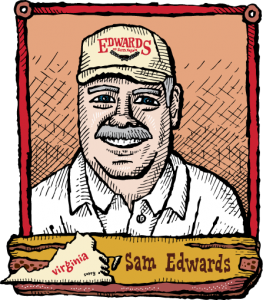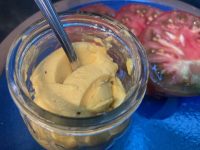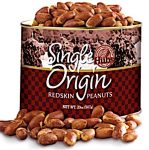First Visit to Camp
 Zingerman’s 4th Annual Camp Bacon is coming soon and Ari recently had a chance to chat with renowned bacon maker Sam Edwards about his first visit to Camp, as well as the history of his family’s business.
Zingerman’s 4th Annual Camp Bacon is coming soon and Ari recently had a chance to chat with renowned bacon maker Sam Edwards about his first visit to Camp, as well as the history of his family’s business.
Coming To Camp for the First Time, An Interview with Third Generation Virginia Bacon Curer Sam Edwards
Sam Edwards is a third generation bacon, ham and sausage maker from Surry, Virginia. We’ve been selling and loving his products pretty much since we opened the Deli back in the early 80s. I wrote a lot about Sam in Zingerman’s Guide to Better Bacon, and Sam’s dry cured bacon is one of the best in the country. We’re all excited that Sam will be coming to Camp Bacon this year to share his family’s traditions, his views on the world of cured pork, and of course a lot of his very tasty, very traditional, dry cured Virginia bacon!
Ari: What are you anticipating in coming to Camp Bacon for the first time?
Sam: I’m excited. I’m expecting big things. I always like to talk bacon enthusiasts. It’s the only Camp Bacon in the world. I’ve never been and I’m excited to get there.
Can you give us a bit of the background on your family’s story in pork curing?
In a nutshell, my grandfather started by selling ham sandwiches on the ferry between Jamestown and Surry. My grandfather married the ferry owner’s daughter. People started asking for the whole ham and so he started selling those in 1926. The first year he cured 55 hams. By the 1940s we were slaughtering our own hogs, and it was evolving into a larger business doing bacon and sausage. We were doing a lot of fresh pork, but by the late 60s he got out of the slaughtering business. He developed his old country sausage. He actually learned it from his mother. His father died young so his mother—my great grandmother—taught my grandfather the art of curing meat.
My dad came into the business in the mid ’40s. He was born in 1930. He grew up in the pork business like I did. The biggest contribution he made was carrying things from curing and aging only in ambient, atmospheric conditions to figuring out what environment was best for what we were doing and then starting to manage that environment more effectively. That was in place by the mid-50s.
How does what you do now compare to what your grandfather taught your father?
We’re still using the old ingredients. My grandfather was talking about the modern problems with pork quality early on. He could see the problems coming. There’s an interview with him from ’60s and said he could see the decline in pork and he felt that was gonna be the decline of the industry. It all really comes down to three things: what the hog is fed, the hog itself and how you cure it. The hog was being industrialized and he could already see that it wasn’t headed to a good place.
It stayed in decline like that for decades, right?
It took until the ’90s till we could get farmers to raise pork in a better way again. 15 to 20 percent of what we buy now is raised sustainably and our goal is to get to 100 percent. There are challenges to making that happen—effectively raise that many hogs sustainably is no small thing. There’s still a lot of bad pork out there—it’s way too lean, rally pale. But things are definitely better. Even the one commodity producer we’re still using is doing a better job than it was even ten years ago.
Tell me about your bacon?
Well, the goal is to dry cure it like we’ve always done it. We cure it for about a week in salt and sugar. Then we smoke it over green hickory for about a day. We go more by color than by time. The higher the humidity outside the longer it takes to smoke. Some times we literally put it in there twice—we smoke it, then chill it down in between, and then put it back in and smoke it again. Then we temper it. For the tempering . . . we like to hold it at about 40 degrees. It loses another 2 to 3 percent in weight during the tempering. Raw to finished weight we lose about 10 in curing most of the time. If we have to double smoke it that way we’ll lose another 2 or 3 percent. Somewhere between 10 to 15 percent.
How does it compare to commercial bacon?
Well . . . That bacon is pumped with water. Because it’s pumped you gotta cook it significantly longer to get it crisp or even a little brown. Normally in an oven at 350° dry cured takes 8-10minutes instead of 15 minutes. It goes in one end on a chain and it comes out three hours later on a chain and it’s called “smoked.” Most of them use liquid smoke, which is a mist that’s sprayed on it. But, it’s a whole lot cheaper.
Do you eat that bacon?
If there’s bacon or ham in a dish on the menu I always have to try it. I was at a conference this weekend. We stayed at a hotel—a nice one—but the bacon was pretty bad. I could hardly tell it was bacon. You could eat it and it had no flavor. And they slice it so thin . . . probably 24 to 28 count (slices per pound) so it was super thin. And it was definitely pumped.
There are some people that do it so they can get the meat back to fresh weight. There are people that add carrageen to it to hold the moisture. They pump in enough liquid to add about25 to 40 percent to the weight and then some leaches back out to so it nets out at 110 of the raw weigh.
What about nitrates?
We use some. We tried some slabs that were cured with nothing but salt, but the meat was so salty. In the old days that didn’t bother people because they were used to that high level of salt. People used that bacon for seasoning meat—they added it soups or to greens instead of adding salt. And the cooking liquid leached a lot of salt out, and then they’d take the bacon out and eat it as their main meat. That was no nitrite but it was really, really salty. We put nitrite in it to give it some shelf stability. You’d only have a week or so. The commercial bacons that say that they’re “no nitrate” use celery or spinach juice. They label ’em as “no nitrites added’ because the nitrates are found naturally in the spinach or the celery. But it’s still in there.
What are your favorite ways to eat bacon?
A friend of mine cut some bacon about 3/8 of an inch thick and we put in the skillet and then we made BLTs out of it that was killer. It was my mother makes this salad with cauliflower and broccoli with a creamy dressing and raisins and bacon. It’s good. She did it when I was a kid to get me to eat my vegetables that’s what she wanted. And I like it real simply with eggs for breakfast. Not cooked too long so you can taste the bacon.




Zingerman’s Art for Sale